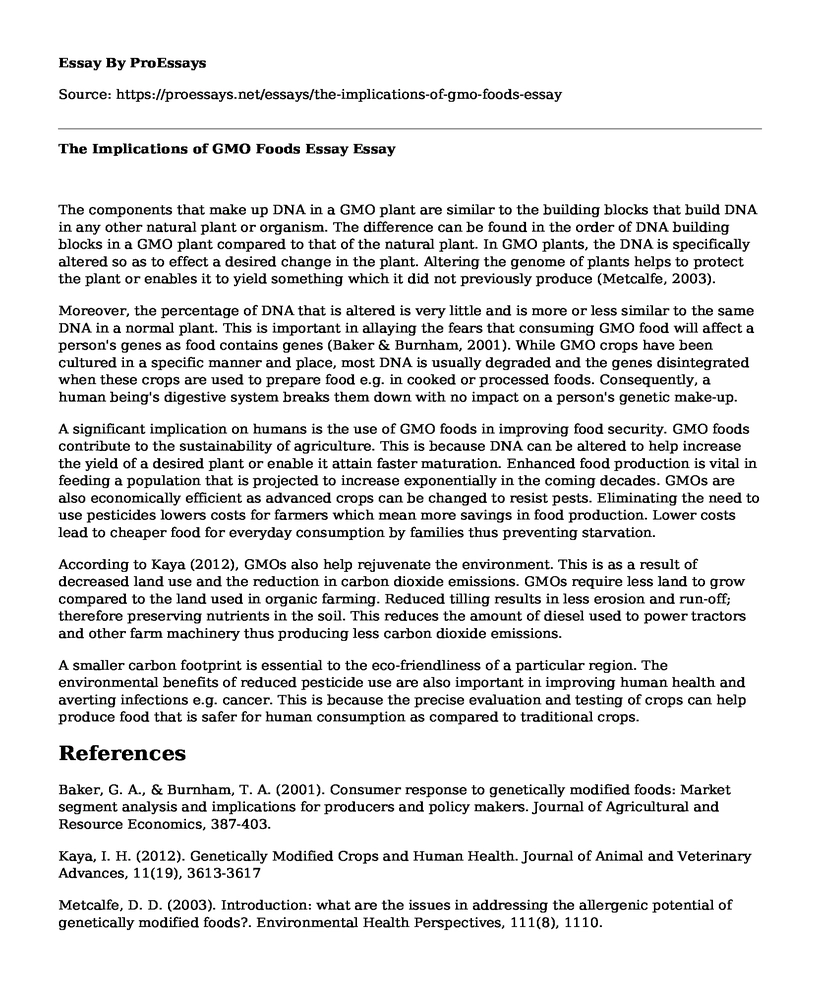The components that make up DNA in a GMO plant are similar to the building blocks that build DNA in any other natural plant or organism. The difference can be found in the order of DNA building blocks in a GMO plant compared to that of the natural plant. In GMO plants, the DNA is specifically altered so as to effect a desired change in the plant. Altering the genome of plants helps to protect the plant or enables it to yield something which it did not previously produce (Metcalfe, 2003).
Moreover, the percentage of DNA that is altered is very little and is more or less similar to the same DNA in a normal plant. This is important in allaying the fears that consuming GMO food will affect a person's genes as food contains genes (Baker & Burnham, 2001). While GMO crops have been cultured in a specific manner and place, most DNA is usually degraded and the genes disintegrated when these crops are used to prepare food e.g. in cooked or processed foods. Consequently, a human being's digestive system breaks them down with no impact on a person's genetic make-up.
A significant implication on humans is the use of GMO foods in improving food security. GMO foods contribute to the sustainability of agriculture. This is because DNA can be altered to help increase the yield of a desired plant or enable it attain faster maturation. Enhanced food production is vital in feeding a population that is projected to increase exponentially in the coming decades. GMOs are also economically efficient as advanced crops can be changed to resist pests. Eliminating the need to use pesticides lowers costs for farmers which mean more savings in food production. Lower costs lead to cheaper food for everyday consumption by families thus preventing starvation.
According to Kaya (2012), GMOs also help rejuvenate the environment. This is as a result of decreased land use and the reduction in carbon dioxide emissions. GMOs require less land to grow compared to the land used in organic farming. Reduced tilling results in less erosion and run-off; therefore preserving nutrients in the soil. This reduces the amount of diesel used to power tractors and other farm machinery thus producing less carbon dioxide emissions.
A smaller carbon footprint is essential to the eco-friendliness of a particular region. The environmental benefits of reduced pesticide use are also important in improving human health and averting infections e.g. cancer. This is because the precise evaluation and testing of crops can help produce food that is safer for human consumption as compared to traditional crops.
References
Baker, G. A., & Burnham, T. A. (2001). Consumer response to genetically modified foods: Market segment analysis and implications for producers and policy makers. Journal of Agricultural and Resource Economics, 387-403.
Kaya, I. H. (2012). Genetically Modified Crops and Human Health. Journal of Animal and Veterinary Advances, 11(19), 3613-3617
Metcalfe, D. D. (2003). Introduction: what are the issues in addressing the allergenic potential of genetically modified foods?. Environmental Health Perspectives, 111(8), 1110.
Cite this page
The Implications of GMO Foods Essay. (2022, May 09). Retrieved from https://proessays.net/essays/the-implications-of-gmo-foods-essay
If you are the original author of this essay and no longer wish to have it published on the ProEssays website, please click below to request its removal:
- Research Paper on Diabetes: Biology of Disease
- Importance of Healthy Eating Essay Example
- Regulation for Nursing Practice Staff Development Meeting - Essay Sample
- Public Health: From Ancient Greece to Today - Essay Sample
- Essay Example on Nursing: Patient Positioning for Physiological Safety
- Essay Example on Applying for Nursing Program at Your Institution: A Confident Step Toward Success
- Free Essay Sample on Modernizing Hammington's Healthcare Services: A Necessity







